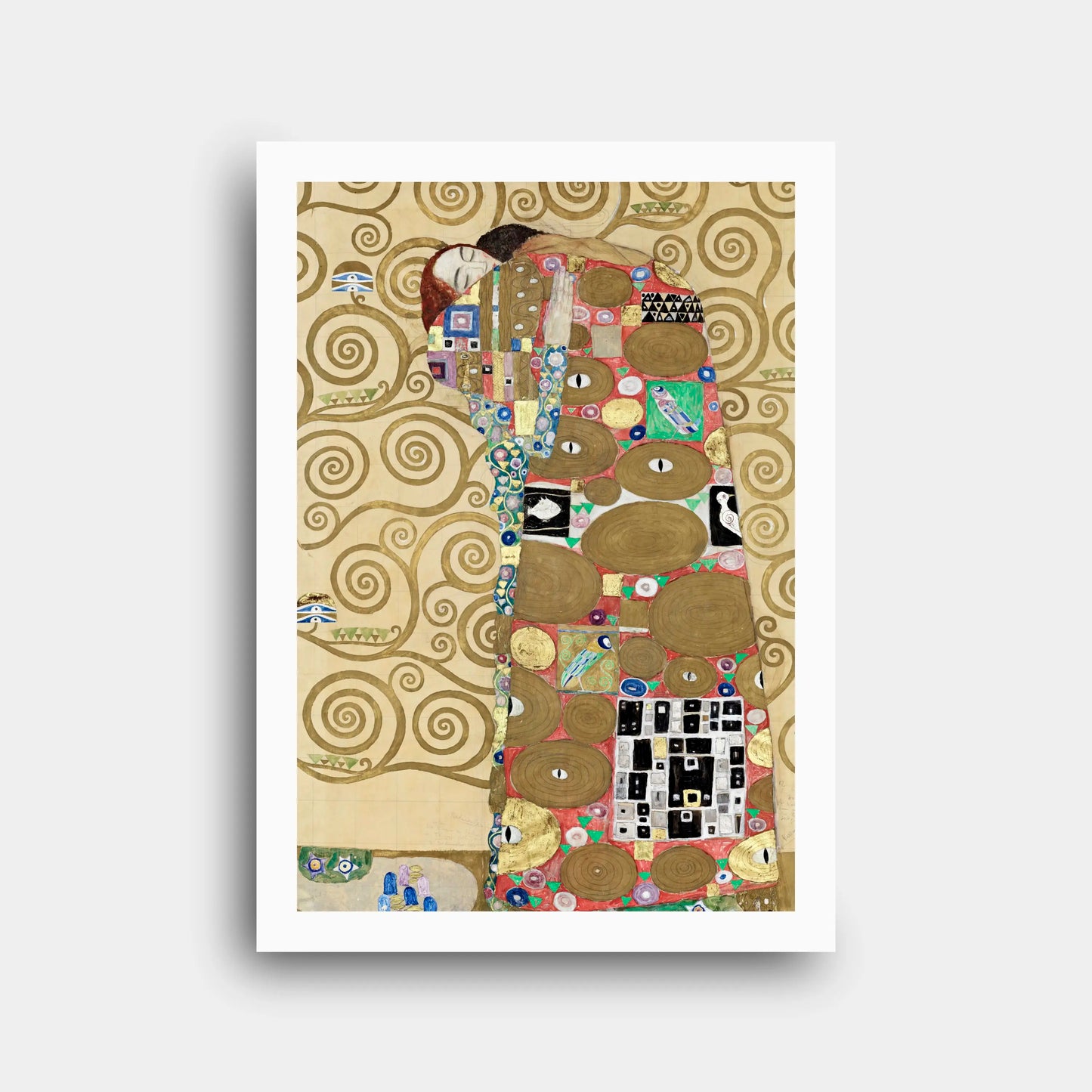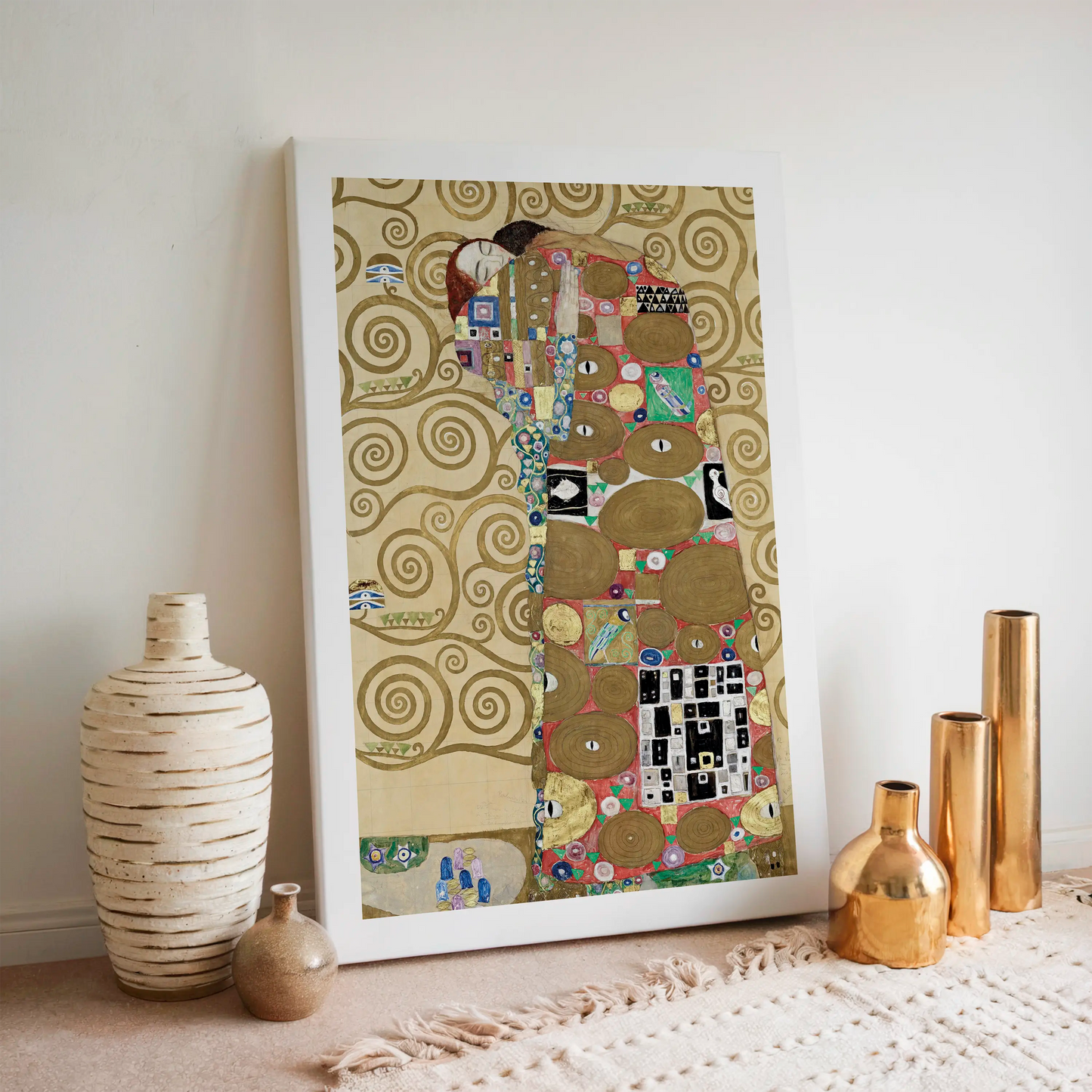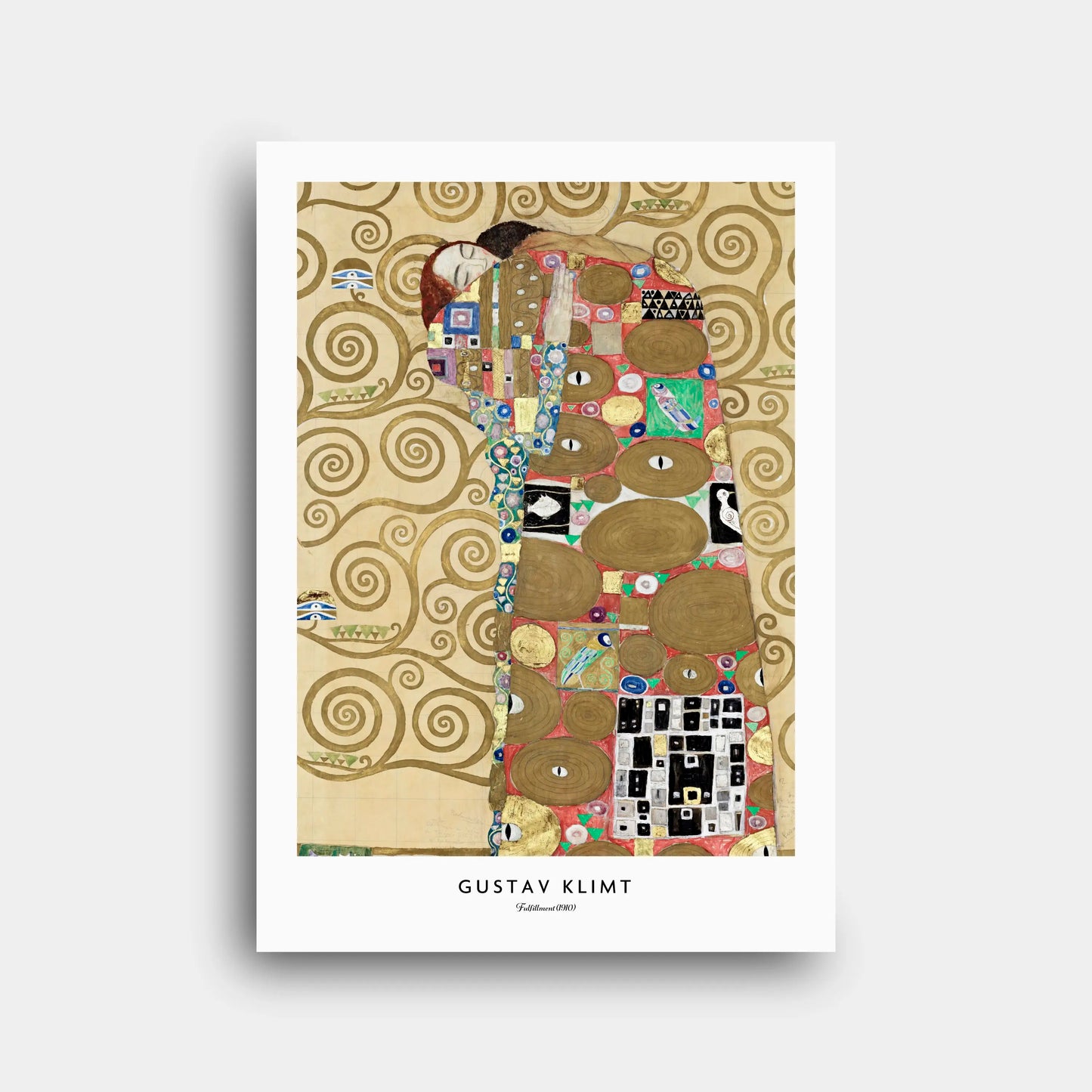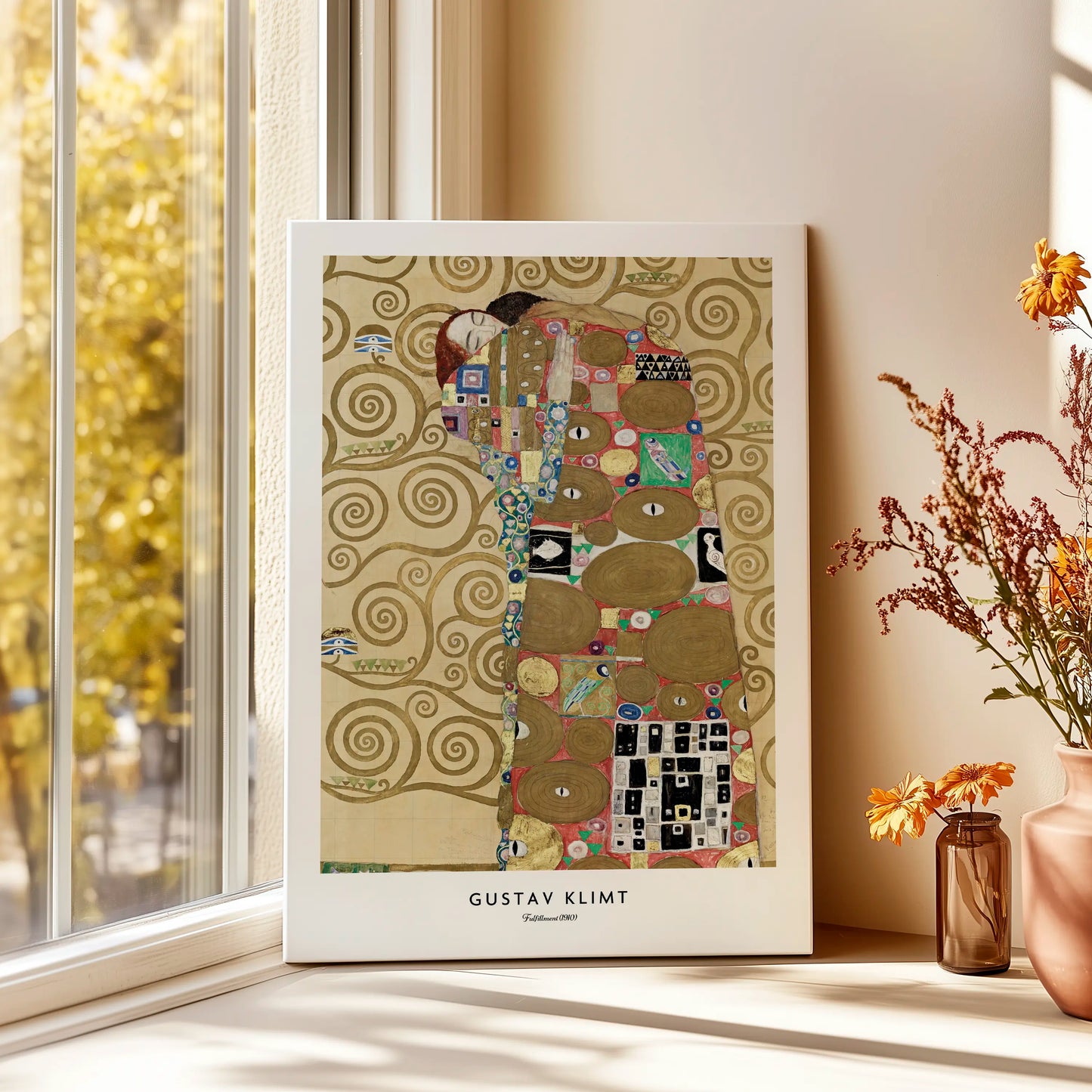Gustav Klimt - Fulfillment (1910) - Canvas Print N175
Gustav Klimt - Fulfillment (1910) - Canvas Print N175
Couldn't load pickup availability
Share
Paper Poster | Canvas Print | Digital File
1. Historical and Artistic Context
Gustav Klimt’s “Fulfillment” (also called “The Embrace”) was created between 1905 and 1909 as part of the monumental Stoclet Frieze. This decorative cycle was commissioned by Adolphe Stoclet for his luxurious Palais Stoclet in Brussels, designed by architect Josef Hoffmann. Klimt was already a central figure in the Vienna Secession, advocating a union of fine and applied arts into a total work of art. “Fulfillment” reflects this ideal by uniting painting, design, and architecture into a single harmonious ensemble. Emerging during Klimt’s Golden Phase, the panel embodies his fascination with love, mythology, and ornament, while showcasing the international reach of Vienna’s avant-garde art scene at the turn of the century.
2. Technical and Stylistic Analysis
The composition depicts a man and woman locked in an intimate embrace, their elongated forms wrapped in ornamental garments. Klimt blurs the boundary between the figures and the richly patterned background, creating a seamless flow of spirals, ovals, and geometric shapes. The swirling golden vines of the Tree of Life fill the space, emphasizing organic rhythm and continuity. The color palette is dominated by shimmering gold tones, enriched with deep reds, emerald greens, and blacks, lending the work a jewel-like radiance. The male figure is adorned with angular, rectilinear motifs, while the female is decorated with soft spirals and floral ornaments, highlighting the contrast between masculine and feminine forces.
3. Symbolism and Interpretation
“Fulfillment” is a symbolic celebration of love and union. The entwined lovers embody not only erotic intimacy but also spiritual wholeness. The Tree of Life represents continuity, growth, and cosmic order, while the spirals suggest eternity and the cyclical nature of existence. Many scholars interpret the couple as allegories of human longing and consummation, with the embrace symbolizing the balance of opposites. The juxtaposition of geometric and organic motifs reinforces the harmony of masculine and feminine energies. Some art historians even link the imagery to Egyptian mythology, with the embrace recalling the union of Isis and Osiris, symbolizing resurrection and eternal life.
4. Technique and Materials
Klimt worked with mixed media on paper for the preparatory cartoons, using gouache, gold leaf, and chalk. For the final mosaic panels installed in the Stoclet Palace, Wiener Werkstätte craftsmen translated Klimt’s designs into an opulent surface composed of marble, ceramic, enamel, semi-precious stones, gilded glass, and precious metals. The integration of gold and silver leaf created a luminous effect, recalling the Byzantine mosaics Klimt admired in Ravenna. This blending of painting, drawing, and mosaic exemplifies Klimt’s experimental approach and his pursuit of a radiant, timeless aesthetic that combined fine art with luxurious craftsmanship.
5. Cultural Impact
“Fulfillment” has had a lasting cultural resonance, even though the original mosaic remains hidden from public view inside the private Stoclet Palace. Its imagery is widely reproduced in books, posters, textiles, and decorative arts, making it a recognizable icon of Viennese Art Nouveau. The work’s synthesis of ornament, symbolism, and architecture influenced modern design movements such as Bauhaus and Constructivism. Klimt’s aesthetic also continues to inspire contemporary fashion and visual design, where the golden patterns and spirals of the Stoclet Frieze are frequently reinterpreted. As a symbol of passion and unity, “Fulfillment” embodies the enduring “vibe” of Klimt’s Golden Phase.
6. Critical Reception and Scholarly Interpretations
At the time of its creation, Klimt’s erotic symbolism was considered provocative by conservative audiences. Critics accused his art of being overly sensual, while admirers praised its originality and modernity. Over time, “Fulfillment” came to be seen as a pinnacle of Symbolist art. Scholars have interpreted it through psychological, mythological, and feminist lenses, emphasizing its celebration of love, femininity, and spiritual union. Today, it is valued as a masterwork of Viennese Secession art, bridging the decorative and the transcendental, and offering a timeless meditation on the human desire for intimacy and completeness.
7. Museum, Provenance and Exhibition History
The original “Fulfillment” mosaic remains in situ in the dining room of the Stoclet Palace in Brussels, a UNESCO World Heritage site that is not open to the public. However, Klimt’s preparatory cartoons for the frieze are preserved in the Museum of Applied Arts (MAK) in Vienna, where they have been displayed in several exhibitions. These drawings offer a rare chance for scholars and visitors to study Klimt’s process. While the palace itself remains private, photographs and reproductions of the frieze have ensured its fame and scholarly attention worldwide.
8. Interesting Facts
1. The work is also known as “The Embrace.”
2. It forms part of the larger Stoclet Frieze, which includes “Expectation” and “Tree of Life.”
3. The Stoclet Palace was declared a UNESCO World Heritage site in 2009.
4. Klimt’s father was a gold engraver, which influenced his fascination with metallic surfaces.
5. The mosaic includes semi-precious stones such as agate and jasper.
6. Some interpret the couple as Klimt and his companion Emilie Flöge.
7. The spirals were inspired by ancient Mesopotamian and Egyptian motifs.
8. The pose of the lovers closely anticipates Klimt’s famous “The Kiss.”
9. The commission nearly overwhelmed Klimt, who feared failure due to its scale.
10. The frieze integrates fine art, design, and architecture, embodying the Secession’s motto “To the Age its Art, to Art its Freedom.”
9. Conclusion
“Fulfillment” stands as one of Klimt’s most important works, uniting eroticism, symbolism, and decorative brilliance into a single vision. It is both a celebration of human intimacy and a triumph of Viennese Secession ideals. Though hidden from public view in the Stoclet Palace, its imagery has reached a global audience, inspiring art, design, and cultural imagination for more than a century. As a culmination of Klimt’s Golden Phase, “Fulfillment” remains a testament to his ability to transform love and ornament into timeless symbols of unity and beauty.











